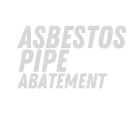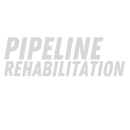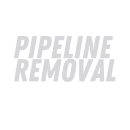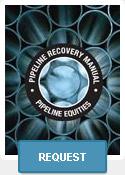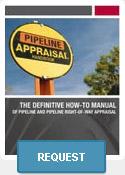The Perceived Asbestos Threat in Abandoned Pipelines
By David Howell
Over the past twenty five years that I have been involved in the pipeline salvage or recovery business, I have had occasion to examine and test pipeline coating for asbestos content and other so called hazardous materials on hundreds of occasions.
Pre excavation due diligence
Whenever my company is looking to buy, trade, or otherwise obtain a pipeline that we might excavate for recycling purposes; the first move we make after determining size, weight, grade, and lengths is to look at the condition of the pipe. Oftentimes, this can only be accomplished by stripping out a segment of the pipeline to examine the existence or repair of the coating and to remove a portion to examine the pipe underneath and to verify by sound measurement instruments the wall thickness of the pipe and thus the weight per foot of the pipe. At the same time we are able to check the exterior condition of the steel by examining the exposed surface.
If possible, we cut a coupon or from the pipe and verify the condition of the interior. The coupon might be 2-3 inches in diameter. This would be big enough to shine a mirror into the interior to further examine the pipe condition to determine if there is residue or corrosion of any consequence. We might also cut a one foot long cylinder section of the pipe to take to a non destructive testing laboratory to check for yield and tensile strength of the steel in the pipe. The yield will be measured in pounds per square inch and the tensile is a hardness test of the metal. These tests determine what we can report to structural customers and also ascertain for what applications the steel can be used.
In another laboratory, we will always take a coating sample from the exterior of the pipe to check for asbestos content that might be embedded in the coating wrap covering the pipe. Asbestos is a highly effective anti corrosive and was used extensively to coat pipeline until the late nineteen eighties when it was outlawed. We check for other materials that might be hazardous as well, but generally the tests are for asbestos content and to what percentage extent. These tests tell us how we are to treat the coating. Can we remove the coating in the field, over the ditch during excavation, or in a cleaning yard or not at all? Is the material friable (free flying)? Can it be transported? What precautions should be taken in transport? Should we wrap the ends with tarps? Do we need asbestos certified personnel on site?
If all is well, we make a decision to obtain and remove the pipeline for salvage purposes or we don’t for one reason or another. The reasons for either might be environmental, economic, or regulatory. More often than not it is an economic reason if we determine not to go through with an excavation job.
Pipe coating removal expense
The process for removing a pipeline with a 10% to 25% asbestos content in the coating can be expensive and challenging.
The cleaning expense can be up to $1.00 per foot or more depending on pipe size. This is cleaning only after the pipe is trucked to a certified pipe cleaning facility.
A certified and asbestos pipe cleaning facility has trained and schooled personnel licensed or trained to work with asbestos in friable or free flying conditions as well as non friable environments. They are trained and knowledgeable in knowing the difference. They are versed in properly removing, sacking, labeling, and disposing of possible hazardous waste materials. These facilities have information regarding the transport to land fills prepared to handle this material.
Additional expense can be trucking of the pipe. The coating can add as much as 10-12% to the weight of the pipe. In these days of $98 oil and $3 to $4 per gallon diesel fuel, the coating is a penalty and creates a cost disadvantage in the hauling. Hauling pipe with coating increases the transportation costs a minimum of 10-12%. Under these circumstances, it is better for the salvage operator if we can clean the coating on site or nearby.
Pipeline Abandonment
Most pipelines are idled or abandoned due to problems on the pipeline such as corrosion or other integrity issues or for the lack of economic use for the system. Viable economic pipelines that have remaining economic life are generally not sold to salvage or pipeline recovery companies such as Pipeline Equities. In almost all cases, when a pipeline has reached the end of its life it is abandoned in place or left to rot and return to earth. This is generally the decision made by virtually all of the former major pipeline operators and owners such as the major oil companies. Often the pipelines were not considered profit centers, but only an in house transportation system.
I have heard one CEO of a pipeline company state that a pipeline with no product going through it has no value. I disagree, but that is the attitude of many in the industry. We have found that a little creativity in a business development unit can find a large number of uses and turn these idle liabilities into active assets. (See “The Search for Abandoned Pipelines” by David Howell, September/October, 2007 issue of International Right of Way Magazine by)
Ownership
In many right of way agreements the terms of the contract dictate the ownership. Sometimes there might be a term of ten or twenty years renewable or it might be in perpetuity as many old Humble Oil and Refining Company pipelines were contracted. More often that not, the line reverts to the landowner whenever the pipeline is abandoned or the intent to abandon is present. Intent to abandon may include factors such as lack of maintenance, non payment of taxes, declaration of abandonment, non- use, or disconnection from a source or supply point. Sometimes when an operator abandons a pipeline the landowners are notified and the ownership of the pipe is transferred to the landowner. Sometimes legal notice is filed as to this transfer and sometimes not.
As landowners become more sophisticated regarding easements and rights of ways crossing their properties the question of ownership and terms of ownership will continue to be asked. At one time after the agreement was filed and the checks for bonuses were deposited the questions were over. The pipe was buried and out of sight and out of mind. Many of those old fields are depleted now and these lines are out of service. They are not viable as they were intended for crude transport and many have become problems.
Pipelines sometimes migrate or otherwise moves around. Sometimes through erosion a pipeline comes to the surface and a plow or excavator or backhoe hits the pipe. We read about these incidents from time to time.
The dilemma is that many pipeline owners are becoming more sensitive about environmental issues.
When the pipeline were laid in the twenties through the seventies, asbestosis, NORM, (Naturally Occurring Radioactive Material), crude residue or product residue in a pipeline was not an issue as no one ever thought the pipeline would see daylight again except for repair or maintenance work. It was buried forever, so they surmised.
The result is that these pipeline owners are now aware of the problems and don’t want to deal with them. The best policy dictated by environmental and legal departments is to leave it alone. Don’t disturb and no one will know and no one will have to deal with the perceived problems.
So the pipeline owners have shed this potential problem for themselves by abandoning these old pipelines in place. They will not sell to a recycler such as Pipeline Equities for fear that we might uncover something that is best laid buried. They often sell some of these assets or liabilities in movie distribution “A movie B movie” style. In other words they might sell a good functioning pipeline that is in demand, but include three out of service, abandoned, or idled lines with it as terms of the agreement. The majors want to deal with other billion dollar players in this regard and there just aren’t that many left. The idea is that the smaller guys might go broke when the boom is over. This bundling process has about run its course and the only buyers left are newer and smaller companies that have come into being with the advent of ninety dollar oil and eight dollar gas. The result is that the pipeline ownership continues to move around and more and more pipelines are abandoned in place and left to deteriorate.
The pipeline operators and owners have found a way to deal with the problem, but that leaves the ultimate ownership of these assets or liabilities on the shoulders of the landowners.
Are pipeline companies who abandon pipelines using the host landowner property as a landfill for their unwanted pipelines and associated environmental issues (Asbestos, norm, migration, deterioration, sinkholes, etc.)
Today, almost any caring landowner is only a Google away from being an expert on abandoned pipelines, Asbestos coating and asbestosis, or a right of way expert. These are not the farmers of your grandfather’s time. These sophisticated and knowledgeable landowners are able to go to the local courthouse and read for themselves the terms and conditions of the easement agreement that was contracted by a prior owner fifty years before. At the very least, the landowner can hire the work done by the many services that are available or hire a one of many lawyers seeking new business and a new notch or two at the expense of a pipeline company.
It appears to me that a better method could be found to dispose of these idled and abandoned pipelines that cross thousands and thousands of miles of farms and ranches, cities and suburbs in America.
In this age of declining resources it seems to make sense to find a way to recycle these commodities. Some companies do take responsibility and have found many ways to turn these perceived liabilities and problems into profit centers. At the very least, by recycling these properties, the companies are taking responsibility to clean up their mess and not passing it own to an unknowing landowner who must deal with the problem at some juncture.


